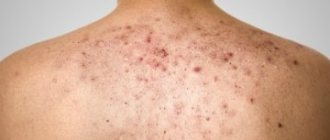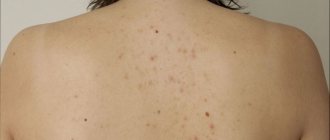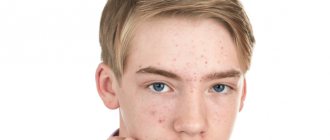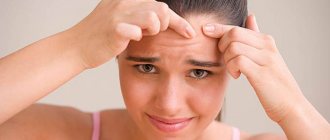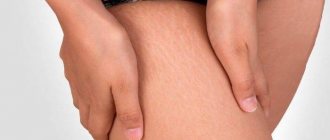Pros and Cons of Squeezing
A large percentage of people are prone to constantly squeezing out all the pimples that appear on the body, regardless of their location. Doctors and cosmetologists insist that this process is not as harmless as it seems at first glance. The reason that a pimple appears on the face or body is an inflammatory process progressing inside the sebaceous glands. Under its influence, excessive production of subcutaneous fat occurs, accumulating in a closed pore.
When an infection penetrates, a favorable environment is created for the reproduction and vital activity of pathogenic bacteria, because they feed on substances collected in the clogged space. This is where the abscess appears.
If the squeezing process is handled incorrectly, the infection spreads locally throughout the body. And if the immune system is weak, then the person will suffer from multiple rashes all over the body. The body is represented by a complex mechanism, and when it senses danger, and this is an infection that has penetrated inside a closed pore, it tries to protect itself as much as possible from its spread. That is, it creates a protective barrier for the deep layers of the skin. With physical activity, pressing with your fingers, this barrier is destroyed, bringing part of the contents out, and the rest is released into the blood.
Moreover, doctors claim that the risk of infection directly depends on the location of the pimple. If it is localized in the area of the nasolabial fold, then it is better not to touch it at all. This is due to the close proximity of the nerve endings to the skin. If the barrier is destroyed, then there is a high risk of infection spreading through the bloodstream directly to the brain. The consequences can be very varied, even death. Here everything depends on the level of the protective function, whether it can suppress pathogenic bacteria. The least that can happen is the appearance of new abscesses in nearby pores.
There is also a high probability that after squeezing, scars will remain. Doctors say that the only correct solution to the problem is to contact a specialist, a dermatologist, who will accurately tell you the reasons and prescribe a treatment regimen.
However, if the pimple is small, then if you follow the rules of squeezing, you can remove it yourself.
Why do acne appear in adolescence and what to do about it?
Adolescence is a difficult time for the skin of almost every person. After all, it is during this period that the dermis is attacked by hated pimples, which make it lumpy and ugly, causing a bunch of complexes and problems. Sometimes such rashes can leave marks on the face and constantly remind you of that difficult period. What are the reasons for the appearance of teenage acne and what to do to ensure that they go away without a trace, this article will tell you.
Reasons for appearance
As teenagers enter a new stage of growing up, they often experience the appearance of acne. The main provocateurs of this disease are the following factors:
- hormonal disbalance. As you know, it is during adolescence that hormonal levels change, and with it the secretion of sebum and the pH of the skin. As a result, ideal conditions are created for pathogenic microorganisms that cause acne;
- poor quality skin care. Some teenagers may neglect the rules of personal hygiene, leaving decorative cosmetics on and simply not washing their face at night, while others use low-quality skin products that clog pores and lead to acne;
- improper acne treatment. To get rid of acne, teenagers abuse cosmetics with a drying effect. As a result, the skin becomes dry, and the body automatically starts active production of sebum to moisturize it. That is why everything should be in moderation;
- allergy. Rashes on the face may be associated with an allergic reaction to cosmetics that teenagers love to wear;
- poor nutrition. Abuse of junk food, as well as a lack of microelements and vitamins (especially vitamin A and B) can cause acne;
- Demodex mite. Do not be alarmed, because this microorganism is present on the skin of almost every person, however, under certain conditions it can become activated and begin its active life, causing acne;
- diseases of internal organs and systems. Mostly, rashes are provoked by diseases of the gastrointestinal tract and endocrine system;
- In girls, acne is most often associated with menstrual irregularities.
Constant stress and heredity can also lead to rashes.
To find out the exact cause of the problem, it is recommended to consult a dermatologist, who can subsequently refer you to an endocrinologist, gastroenterologist, gynecologist and some other doctors. These specialists will tell you whether the problem is related to a disease of internal organs or systems. If suspicions are confirmed, then treatment must begin with the main cause, and only then eliminate its consequences in the form of acne. However, most often acne in adolescence is associated precisely with changes in the body during this period of growing up.
What and how to squeeze them out?
Oddly enough, despite all the negativity regarding extrusion on the part of doctors, medical equipment manufacturers still produce special instruments for this procedure. They are represented by a Vidal needle and a Uno spoon.
Now let's look at the whole process in detail:
- The first thing you need to do is wash your hands thoroughly with soap, perhaps more than once. This is necessary to remove germs from the skin; after washing, you can also lubricate your hands with an antiseptic, or rinse with a chamomile solution;
- Then wash well if the pimple is on your face, or take a shower. The body must be clean, free of any signs of cosmetics, makeup, sweat or dust. A disinfectant, such as alcohol, should be used to treat the skin around the radius of the pimple. This will also protect against the penetration of pathogenic microflora into the body. To rub, use a soft swab or cotton pad, and do not rub the affected area too hard;
- Now you need to thoroughly steam the area where the pimple is located. A steam bath is suitable for this if it is on the face, or applying a warm compress from a damp towel for 15 minutes. Everything that is done at this stage is aimed at opening the pores as completely as possible;
- Next, pat your skin dry with a clean, dry towel or paper napkin. To avoid infection, it is recommended to wear sterile medical gloves, or wrap your fingers in a bandage;
- When using special tools, they should also be disinfected: boil in boiling water, wipe with alcohol, sprinkle with antiseptic;
- Now perform gentle pressing movements on the skin near the pimple, but do not touch the head itself;
- When the contents are released, disinfection measures must be carried out again.
The appearance of a small drop of blood will indicate that all the pus has come out. The process should be completed at this point so as not to cause injury to the damaged area. You can relieve inflammation and get rid of redness by applying an ice cube.
Treatment
Having found out the origin of the problem, it is necessary to begin to solve it. What to do if acne does not go away is the next question to be answered. Based on the results of a consultation with a dermatologist (and often with the involvement of other specialists), an individual therapeutic program is formed for each patient, containing the most effective ways to eliminate acne and prevent its recurrence.
Medicines
The basis of acne treatment is drug correction. Acne treatment regimens contain external preparations with the following components:
- Antibiotics (erythromycin, clindamycin).
- Salicylic and azelaic acids.
- Retinoids (isotretinoin, adapalene).
- Benzoyl peroxide.
- Zinc acetate.
Acne that does not go away within a year usually requires complex therapy, which includes systemic medications. Tetracycline antibiotics, retinoids, vitamins and immunomodulators can all be used to eliminate acne. If a subcutaneous pimple persists due to demodicosis, then antiparasitic (metronidazole) and antihistamines are recommended.
Facial care
Proper facial skin care plays an important role in the fight against acne. For those whose pimple does not go away for a long time, you need to pay attention to the following points:
- Cleansing (makeup removal, washing twice a day with gel or foam, but not soap).
- Disinfection (alcohol-free lotion).
- Exfoliation (scrubs, peelings).
At the same time, it is important to avoid excessive degreasing of the skin with aggressive agents, since they destroy the lipid mantle, dehydrate and provoke increased production of sebum. It is necessary to select cosmetics that correspond to the problematic epithelium.
Masks are a good way to combat the imperfections of problem skin. There are both store-bought and homemade recipes. The following are widely used in anti-acne cosmetic compositions:
- White clay.
- Activated carbon.
- Egg white.
- Lemon juice.
- Cereals.
- Kefir, etc.
Before applying them, it is recommended to steam your face so that the mouths of the sebaceous glands are better opened and cleared of plugs. A good effect in eliminating comedones can be obtained using film masks that draw out deeper impurities, as well as products with fruit acids (citric, lactic, glycolic).
Any acne, especially a pimple that has not gone away for several years, should not be squeezed out. This will only lead to the spread of infection and the appearance of scars. Manual cleaning in beauty salons is also contraindicated. And you shouldn’t even touch your face with unwashed hands.
Pimples that won’t go away are treated with comprehensive facial skin care. It suggests several important points to improve the condition of the problematic epithelium.
Diet
To make a pimple on your face go away faster, you should also take care of proper nutrition. Increased activity of the sebaceous glands may be associated with the consumption of the following products:
- Sweets and baked goods.
- Fatty and smoked meats.
- Spices, sauces, marinades.
- Alcoholic drinks, coffee.
Instead, you need to increase the amount of fruits and vegetables, herbs, cereals, fish, and lean meats in your diet. For drinks, it is recommended to prefer natural juices, still water, and compotes.
For some people suffering from acne, it happens that the acne does not go away for quite a long time (several months, or maybe even years). The reason for this may be various factors, usually associated with deficiencies in the provision of cosmetology and medical care or violation of the specialist’s recommendations by the patient himself. And in order to get rid of the problem for a long time and prevent the recurrence of acne, all identified defects should be corrected.
What do the professionals advise?
Just knowing about the technology and tools for squeezing pimples is not enough. It is very important to prevent new acne from appearing in the affected area. It is recommended to perform daily hygiene procedures exclusively with clean water, which maintains the acid-base balance.
Also, do not forget about changing bed linen (at least twice a week).
If pimples appear, under no circumstances squeeze them out with dirty hands on uncleansed skin. If acne occurs, it is better to refrain from removing it altogether; usually, it goes away on its own after three days.
At what age do acne go away?
For most people, acne goes away on its own, when the process of forming the entire set of “hormones” ends, and proper regulation of the sebaceous glands begins. Usually, such happiness occurs in the early or mid-20s of a guy or girl’s life. Teenagers who are luckier not having to squeeze out pimples in their youth, may find that their acne will stop in their late teens around age 17 or 18.
For those who did not consult a dermatologist in time or treated acne with inappropriate treatment methods, you will have to wait a little to get rid of acne completely. Also, there are often cases when, after acne clears from the face and body, it takes another half a year - a year to treat post-acne, which is a consequence of squeezing and other incorrect methods of treating acne.
